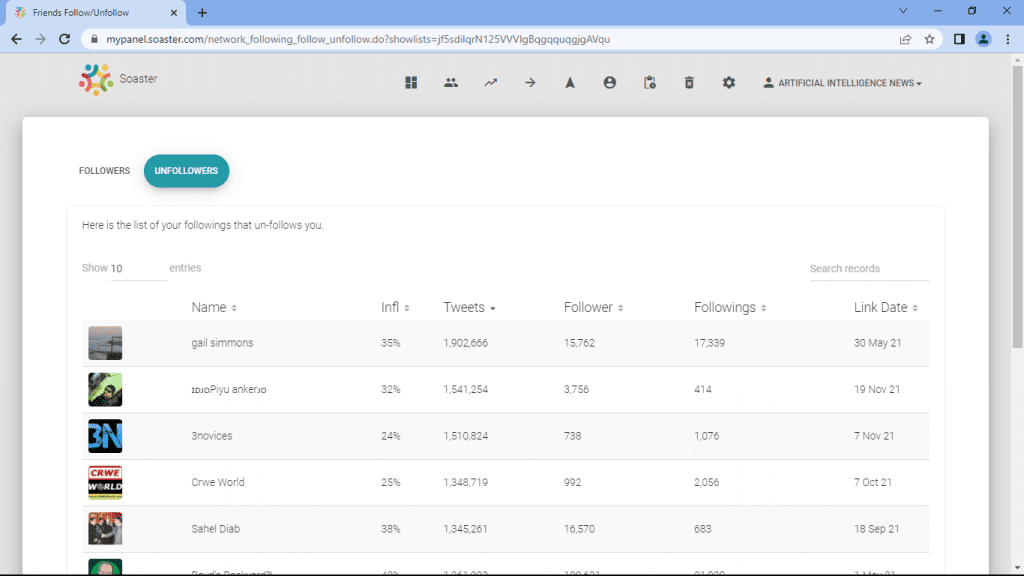Have you noticed that some of the accounts you follow on Twitter are not following you back? It might not seem like a big deal, but most likely you have asked yourself this question: Who is not following me back on Twitter?
Since organic growth is important, it’s worth paying attention to who is following and who is not following you back on Twitter
Table of Contents
ToggleWhy should I look for who is not following me back?
If reciprocal following is important to you, you’d like to see all the accounts you follow start following you back. However, most of the time, it doesn’t work this way. When you don’t receive follow-backs from hundreds of accounts you follow, this will cause a negative impact on your profile’s reputation.
So, you should regularly check the accounts that don’t follow you back, since the accounts you follow and who follow you back can impact your Twitter experience in several ways:
Twitter is a two-way conversation
Twitter is mostly about making connections and having conversations. It can feel one-sided and be challenging to engage with someone if you follow them but they don’t follow you back. You can concentrate on establishing a relationship with people who are interested in what you have to say by paying attention to who follows you back.
Reciprocal following plays a significant role in increasing your follower count, especially if you are new to Twitter. For that reason, you should regularly check to see who is not following you back on Twitter, particularly at the beginning of your Twitter journey.
It can help you prioritize your content
You can get a better idea of the type of content your audience is most interested in by keeping track of your followers. It might be a good idea to reevaluate your strategy and focus more on content creation if you notice that certain people who are not following you back are not interested in the content you are sharing.
It might affect your reach
The tweets that are shown in your feed are selected by Twitter’s algorithm. Your tweets’ reach may be limited if you don’t have a reasonable amount of followers. Low follower count will make it more difficult to be visible for your content. You can increase the likelihood that more people will see your tweets by improving your engagement with others. The more people engage with your tweets the more they will get impression on the platform. If you can’t get follow-back from the accounts you follow you will not be able to increase your reach.
How to find out who is not following back on Twitter
As mentioned earlier it is important to track regularly your follower list. There are two ways to know who is not following you back on Twitter:
Utilize the “following” feature on Twitter.
You can see a list of everyone you are following on Twitter by using the built-in “following” feature. Go to your profile and select the “following” tab to access this feature. You can then scroll down the list to see which users are not following back.
This will take you a lot of time if you are following hundreds or thousands of accounts. So, looking for non-followers manually is not an effective way.
Use a Twitter follower tracker
There are a couple of secure and powerful tools and apps available that can help you quickly and easily see who is not following you back on Twitter.
One of these tools is Soaster. With Soaser you can easily track all the accounts that are not following you back.
To access this feature first subscribe to Soaster.
After Soaster is synchronized with your Twitter account, go to “Following Engagements”, then click “Unfollowers.”
The “Unfollowers” feature displays a list of accounts that are not following you back and allows you to decide whether to unfollow them or attempt to gain their attention and potentially get them to follow back. You can also sort the list by date to see when you followed those accounts.

In sum, finding out who isn’t following you back on Twitter can be beneficial for establishing connections and enhancing the reach of your content. You can concentrate on creating connections with people who are interested in what you have to say. You can achieve this by keeping track of who is following you back and who is not. After that, you can prioritize your content accordingly.
Should I unfollow the accounts that don’t follow me back?
The decision to unfollow accounts on Twitter that aren’t following you back is ultimately yours. Both strategies have advantages and disadvantages.
Streamline your feed
On one hand, streamlining your feed and concentrating on establishing connections with followers who are interested in what you have to say can be accomplished by unfollowing accounts that are not following you back. You can cut down on the number of tweets in your feed and concentrate on the accounts that are most valuable and relevant to you by unfollowing those who are not following you back. As a result, your ability to interact with your followers will likely increase, and your tweets will have a greater reach and impact.
Be selective
On the other hand, waiting a bit before unfollowing accounts that are not following you back can give those users a chance to follow you back if they are interested in your content. It can also allow you to see if those users might engage with your tweets in the future, which can be a good indicator of whether or not it’s worth continuing to follow them.
Be selective about who you follow: It’s important to be selective about who you follow on Twitter to ensure that your feed is relevant and valuable to you. If you notice that certain accounts are not providing value or are not interested in your content, it might be worth unfollowing them.
Follower to following ratio
Another reason to unfollow those who don’t follow back is establishing a good follower to following ratio.
The follower to following ratio is the ratio of the number of followers a user has on a social media platform to the number of accounts they are following. For example, if a user has 100 followers and is following 50 accounts, their follower to following ratio would be 100:50. This ratio is often used as a measure of the popularity or influence of a social media account.
Some people believe that a high follower to following ratio is a sign that the account owner is selective about who they follow and is therefore more likely to be an authority or influencer in their field. However, it is important to note that this is not always the case, and there are many other factors that contribute to an account’s influence and reach.
So, if you believe that following much more accounts than your followers ruins your account’s reputation, then it will be a good decision to lower the count of the accounts you follow.
Conclusion
“Who is not following me back?” is a question that most of the Twitter users ask themselves at some point. It’s important to know who is and isn’t following you back so that you can keep track of your followers, avoid being annoying, and understand why people aren’t following back.





